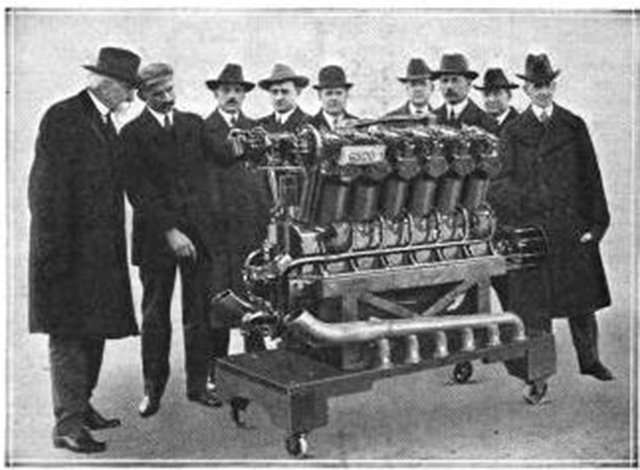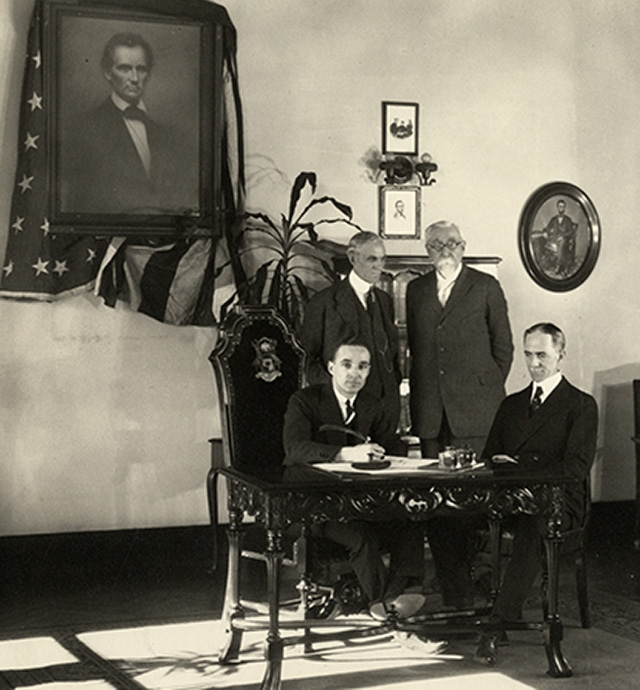
In 1917, Henry Leland and his son Wilfred left their management positions at Cadillac Motors to form the Lincoln Motor Company after GM President Billy Durant refused to let them use part of the Cadillac plant for military production during World War I. American military planners were troubled by German dominance of the air over Europe’s battlefields, so even before the United States entered the war, they asked the Packard Motor Company to adapt its Twin Six motor for military use.
In the spring of 1917, the U.S. government ordered 22,000 Liberty Aircraft engines developed by Packard. By the war’s end, 90% of the engines manufactured in the U.S. were produced by Lincoln, Ford, Cadillac, or Packard.
 Lincoln Motor Company executives with the 6500th Liberty Engine (1917)
Lincoln Motor Company executives with the 6500th Liberty Engine (1917)
Designed by architect George D. Mason and constructed by Walbridge Aldinger, Leland’s Lincoln plant was built at breakneck speed. Just seven months after breaking ground, the factory produced its first engine. Lincoln claimed that, over the course of the war, it built more engines than any other Allied manufacturer. Lincoln’s 6,000 employees could turn out 50 engines per day – as many as English manufacturers, with 10,000 employees, could produce in a week.
After the war, the Lelands sought to launch a new luxury car model under the Lincoln marque. Their first vehicles sold out within three hours of being offered to the public. But Lincoln was not to be a success story. The cancellation of a substantial portion of its war contract made the Lincoln plant debt almost impossible to service. When the firm’s financial backers withdrew in 1921, Lincoln was thrown into receivership.
 Sale Document Signing Ceremony
Sale Document Signing Ceremony
Seated Edsel: Ford & Wilfred Leland Standing: Henry Ford & Henry Leland
In a last-ditch effort to sustain the enterprise, Wilfred initiated merger negotiations with Edsel Ford. He opened up the negotiations with Edsel rather than with Henry Ford, his father’s arch-competitor. But ambiguity over who was to repay the stockholders was not settled by the agreement. Within a month after the sale, the disagreement came to a head and the Lelands were dismissed. This gave the Fords full control over Lincoln. The intense business and civic rivalry between the two auto giants, which had spanned decades, was brought to a bitter end for the Lelands. Legal entanglements were to continue through 1931.
At a time when the Model T was still the company’s signature vehicle, Ford saw the acquisition of Lincoln as a way to regain a prominent place among luxury automaker marquess like Cadillac, Packard, and Duesenberg. The streamlined design of the Lincoln Zephyr, introduced in 1935, was developed under the direction of Edsel Ford and increased the company’s sales nine-fold. The acclaimed Continental went into full production in 1940, just three years before Edsel’s death. During World War II, the Lincoln plant was part of a companywide effort to produce tank engines as well as Jeep and amphibious vehicle bodies.
Ford’s Lincoln and Mercury divisions merged in 1945 and production on both lines continued at the same facility until 1952, when their manufacture was transferred to other plants. The site was sold; later, several of the plant’s structures were demolished. The former Lincoln production site is now a DTE Energy service center
Click the links below for more information on Henry Leland’s storied career and the early years of the Ford Lincoln Division:
Henry Leland’s Career
The Grand Old Man of Detroit, a MotorCities “Story of the Week” originally posted on 2.17.2008, that traces Leland’s early career at Leland & Falconer and Cadillac.
The Leland Contribution to Motordom, a 1920 Lincoln advertisement placed in Outlook, a prominent national publication which highlights the Lelands’ contributions to the evolution of automobile manufacturing.
Organization – Equipment – Knowing – how Produces the New Leland-built Lincoln Car Volume 125, pg. 656, a 1920 advertisement from Outlook magazine recounting the motor company’s war production record just as Lincoln was about to launch its first automobile.
19th Century Man: The Rise and Fall of Henry Martyn Leland, a post from the Ate Up with Motor: Portraits of Auto History website. This essay offers additional detail on both the dispute between the War Department and the Lelands as well as Ford’s takeover of Lincoln Motors.
Henry Leland’s civic involvements and views of organized labor, a discussion produced by the Guide’s project team to explore Henry Leland’s interest in civic affairs and his opposition to unions.
The Lincoln Brand
1941 Lincoln Zephyr’s Streamlined Design an article from the MotorCities newsletter written by Robert Tate exploring the influential Lincoln Zephyr models produced just before World War II.
History of the Lincoln Motor Car Company, a short video produced in 2000 by Michael Kuentz Communications, LLC for the Ford Communications Network tracing the evolution of the Lincoln brand.
TEXT – DIANNE FEELEY / RESEARCH – DIANNE FEELEY & RON ALPERN
PHOTO CREDITS
Detroit Historical Society
Lincoln Plant
Detroit Public Library, Burton Historical Collection
Fords and Lelands
Detroit Public Library, National Automotive History Collection



